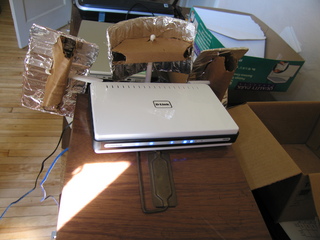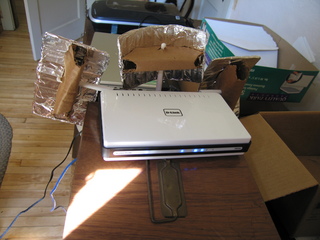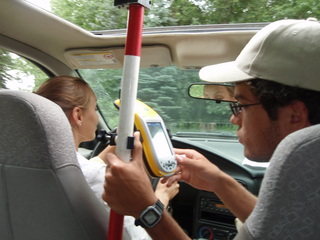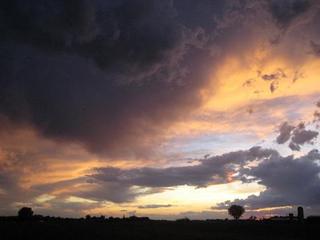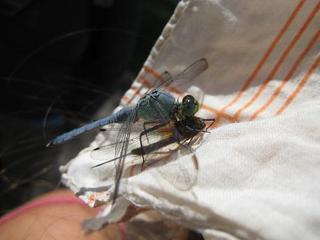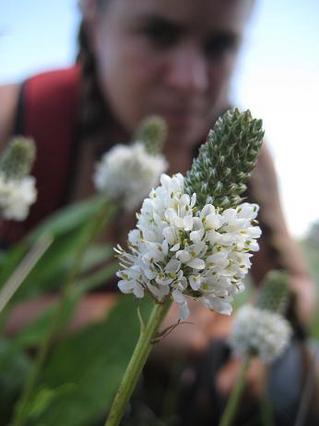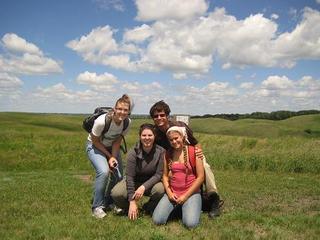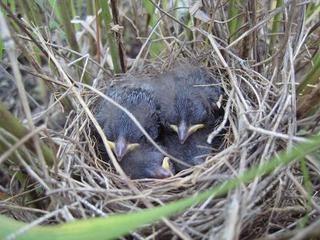|
|
So, for another update from the luxurious Hjelm house, which is THE place to be this summer. We recently had the wireless router in the basement stop allowing people to log on to the network wirelessly, so Stuart ordered a new wireless router, along with an 8 port switch so that we can have more than 3 computers connected at the same time. They got here yesterday, and I took them downstairs to set up.
The entire process of setting up took about 20 minutes, and everything worked like a charm. I hooked the cable modem up to the router, set up the router DHCP (Dynamic Host Configuration Protocol, used to assign IP addresses to computers on the network), and hooked the router up to the switch, after mounting them on the wall. However, I wanted to see if we could get wireless access in the Wagenius house, about 60 metres away.
Setting the router up near the window in the basement did not work, so I moved the router upstairs. After a couple hours trying various spots, it was placed in Stuart’s office, which offered easy access to an Ethernet jack, as well as a convenient window.
In order to enable both the wireless router and the wall jacks, while preserving the network, I had to disable DHCP on the new wireless router, and place the old one downstairs to act as a DHCP distributing thingy for the house. It took me a couple hours to figure this out as well, since I thought the wireless router could perform the same function through the switch.
Anyway, to cut a long boring story short, the new router upstairs fell just short of the Wagenius house computer’s range, so using the excellent resources of (Lifehack.com, I made three parabolic reflectors out of cardboard and tin foil to boost the signal. They worked like a charm! They are originally the idea of this site: http://www.freeantennas.com/projects/template/, and I got the template to build the antennas from here: http://www.freeantennas.com/projects/template2/index.html.
Some pictures of the new wireless router:


So, I know I have been missing from the flog lately, but that is only because I was saving up all my flog posts to make one huge, wonderful one! But this is not that post. First of all,
AphidSearch09FinalVersion.mdb
Here is the aphid search data for the past 6 weeks. Each plant has a unique RecordID that identifies it though all three tables. The UnitID field, while it might seem repetitive, is just from the format used on the Hjelm house computer. We have found 263 plants so far, but about 20 of them were can’t finds in following weeks.
This still lacks the transect searches that we will do next week, at which time I shal post an updated version. Note that even though this says Final version, this is just where I save all the final versions of my tables, as opposed to the working versions I use to sort out the tables.
Gretel- KJ’s
Mimi- Railroad Crossing
Allegra- Landfill East
Stuart- Staffanson
Amy- Steven’s Approach
Amanda- Yellow Orchid Hill
Daniel- Aanenson
Kate- Riley
Caroline- On 27
Greg- Loeffler’s Corner
See you guys at 7:30ish at Hjelm House!
xoxo,
Amanda
We have made a few changes to the protocol for tomorrow’s FINAL outing for pollinator observation and collection:
1) DO NOT capture syrphid flies!
2) If you observe a small common syrphid fly (Family: Syrphidae, Sphaerophoria sp.) on your Echinacea head, make a note that one SCSF was observed. Here are some photos of syrphid flies:
http://echinacea.umn.edu/insects/images/poll2005vin1948side.jpg
http://echinacea.umn.edu/insects/images/poll2005vin1927top.jpg
http://echinacea.umn.edu/insects/images/poll2005vin1927front.jpg
Here’s a video that might help:
http://www.youtube.com/watch?v=UkjPfAMGmiw&NR=1
———————————————————————————————
As for pollinator collection and analysis…
We’ve gone out collecting three times now (tomorrow is the fourth and final day), and we have about 140 Echinacea insect visitors in vials in the freezer. Here is my protocol for making slides and labeling specimens:
1) Remove vial from the freezer and allow insect to thaw
2) Cut a very small (2mm cubed) piece of agar and situate it in the middle of a slide.
3) Remove the insect from the tube and dab and sweep every surface of the body across the agar cube. This is intended to simulate the amount of pollen that might be transferred to Echinacea styles during a visit.
4) Set the insect aside on Styrofoam.
5) Sweep the inside of the vial with the agar cube for any loose pollen.
6) Place a cover slip atop the agar cube and put the slide on the edge of a hotplate on LOW heat. Watch the slide carefully and remove it when the agar is soft but not melted (once melting starts, it will quickly boil and create bubbles in the slide).
7) Pin the insect (for identification if it is an unknown species, or quick-n-casual for a known species) and pin it with a new one letter, three number code.
8) Label the slide with the vial code and the specimen code.
Photos:
I photograph the slides on the same day as I make them so that the agar doesn’t dry out before the photo. To sample the slides, I have generated random pairs of numbers from 1 to 22 (inclusive). The cover slips are 22 x 22 mm and I use the ruler on the microscope to scroll to the randomly selected “plots” from one corner of the cover slip. From there, I take the photo at 40x. I take ten photos for each slide, and sometimes take more than one photo per plot if I capturing all of the pollen grains requires multiple focuses.
I will post some photos of this process soon, so hang in there!
As always, feel free to leave questions or comments.
Thanks!!
Amanda
So, there has been a serious lack of pictures lately (aside from those awesome Stipa scans), so I am posting a bunch of pictures taken a while ago, just so you can see what we are up to:
http://www.flickr.com/photos/danrath/3727546804/
Amanda in her little corner of the farmhouse, doing voodoo with bees.
http://www.flickr.com/photos/danrath/3726738091/
http://www.flickr.com/photos/danrath/3726739525/
http://www.flickr.com/photos/danrath/3726736903/
Greg and Kate locked away in the Basement of Oppression
http://www.flickr.com/photos/danrath/3727538558/
http://www.flickr.com/photos/danrath/3727532876/
http://www.flickr.com/photos/danrath/3726727059/
http://www.flickr.com/photos/danrath/3727301314/
Berry Picking, starting with Caroline’s Gollum face. We have picked at least 20 buckets of berries from these people.
http://www.flickr.com/photos/danrath/3727297280/
http://www.flickr.com/photos/danrath/3726488747/
http://www.flickr.com/photos/danrath/3726486389/ – Aphids, the enemy.
Insects in the Common Garden that I found while searching for plants
http://www.flickr.com/photos/danrath/3726483267/
Mimi broadcasting Stipa grass
We spent most of yesterday collecting pollinators and measuring plants in the Common Garden. (It has never taken me 3 hours to go 30 metres before, but all the plants I measured seemed to be in the middle of a grass clump). I have also figured out a procedure for refinding plants in the transects, and it should not take very long to refind all of them. This is good, as I might be working by myself to do that.
Hello all!
This is Daniel with another update on what team Echinacea has been up to in the past week. Allegra, Stuart and I have become what I like to call the “Staffanson Crew”, and we are responsible for doing phenology at Staffanson every other day. Today we got the time down to about 2 hours and 20 minutes, from 3.5 hours originally. The process was made a lot more efficient by splitting up sections and giving everyone a separate checklist. Of course, the temperature was almost 40 below, so that was slightly unpleasant. Add the wind and the fact that I was only wearing 2 thin layers, and you have a recipe for hypothermia. However, I persevered, thinking of my avocado and sausage sandwiches waiting for me at the Hjelm house.
The pollinator project has been going along well, with Kate, Amanda and Mimi hard at working sorting out the oodles of data they have obtained. Greg and Kate are based in what I like to call the “Basement of Oppression”, working on making slides and taking pollen photos. Amanda is pinning bees and creating agar slides with the different pollen loads, then photographing them. Finally, Mimi is working on sorting out all the different types of flowering plants found at each sites. Meanwhile, who knows what Amy and Caroline are up to? Reviewing papers and entering data most likely, tasks far beyond the comprehension of we undergrads.
In my case, I have been searching for the different plants in the common garden that we identified as having spittle. I spent all afternoon in the common garden yesterday, and it was a ton of fun, especially since I saw so many interesting things. The most interesting thing of all though, was watching a bunch of ants pick up and move an aphid that was sitting on a leaf. The aphid may have been dead or alive (alive would be so cool!), but since I was silly enough to forget my camera, I guess I’ll never know.
Most of the plants I looked at have aphids on them, but I will need to wait until I finish looking at them all before I draw any conclusions. Meanwhile, our transect searches are done until next week. However, I have found aphids on many of the plants I saw during our Staffanson searches, so I remain hopeful!
This morning, Amy and I searched transects in Staffanson. We did random points 15, 36, 19, 5, 20, 40, 12, 28, 1, 14, 3, 37 and 27. They were 10 metre long and half meter wide transects, some of them half a kilometre apart. We found 1 plant (!) total in the transects, and 3 plants nearby.
*whew*. Lotta walking…
So, for those of you who were wondering what Team Echinacea will be doing tomorrow, here is the field protocol for the transect searches that we will be using.
Field Protocol.doc
Any questions, please let us know!
Also, we were searching for Stipa today (a prairie grass that Dr. Ridley is planning to add to the common garden), and this is the setup we used to mark the sites with the GPS:

The antenna allowed us to get about a 9 cm margin of error when using the Trimble. And yes, that is yours truly manning the antenna, ensuring that the carrier lock is not lost. We were all ready to tell the next person who asked us what it was that we were searching for nuclear waste.

A certain someone has thrown the digital gauntlet down, and being who I am, I cannot stand by and let that someone’s remarks pass. Generations of Raths back to the Dark Ages would roll over in their graves were their descendant to back down, spineless, before a challenge. I shall outmaneuver my opponent by focusing on quality, not quantity. My posts shall be masterpieces of prose and picture, and my adversary shall soon bow down, defeated.
Today was a rather productive day, as Amy and I flagged transects in Nessman, Stephen’s Approach, KJ’s, Northwest of Landfill, and East Riley. They all went fairly quickly one we got the procedure down: Determine where the plants correspond to the map, lay down the first metre tape, choose and flag random spots on the length of the tape, measure outwards from that tape to the edge of the remnant, and flag that point as well. After that, we put in shiners and tags so that we could be sure of finding them again. We also flagged plants for Jennifer’s and Diedre’s tissue samples.
Pictures below are of:
 A beautiful sunset outside Kensington. I cannot get used to the fact that the sun sets around 10 out here! A beautiful sunset outside Kensington. I cannot get used to the fact that the sun sets around 10 out here!
 A dragonfly eating another dragonfly at Glacier Lakes National Park. This one just kinda landed on Allegra’s head. A dragonfly eating another dragonfly at Glacier Lakes National Park. This one just kinda landed on Allegra’s head.
 Prairie Clover! There was a lot of this at Glacier Lakes, which made the prairie that much more beautiful. Prairie Clover! There was a lot of this at Glacier Lakes, which made the prairie that much more beautiful.
 Members of Team Echinacea: Mimi, Kate, Daniel and Allegra at Glacier Lakes. Such a nice day! Members of Team Echinacea: Mimi, Kate, Daniel and Allegra at Glacier Lakes. Such a nice day!
 Even though we were not at work, we could not stop ourselves from searching for seedlings! Didn’t find any though. Even though we were not at work, we could not stop ourselves from searching for seedlings! Didn’t find any though.
 There is a nest of baby birds in the Common Garden in row 41 that I found a week or two ago. There were only eggs at first, but they hatched and are now sprouting quills! Expect updates on these guys as well as regular pictures! There is a nest of baby birds in the Common Garden in row 41 that I found a week or two ago. There were only eggs at first, but they hatched and are now sprouting quills! Expect updates on these guys as well as regular pictures!
Note: As I was writing this, Dr. Ridley walked in carrying two Pappa John’s pizzas as a break from the healthy salads we have been eating all week! A move worthy of a saint!
Here is an outline of the form needed for doing the aphid searches:
Rosette Count
Leaf Count
Length of Longest leaf – cm
Ant Presence – Yes/No
Size of Aphid Infestation (Required Field) – Categories 0, 1, 2-10, 11-80, >80
Count of Leaves with Aphids
Spittlebug Presence – Yes/No
Distance from Plant to Spittlebug – 0 if on the Echinacea Plant itself
|
|

